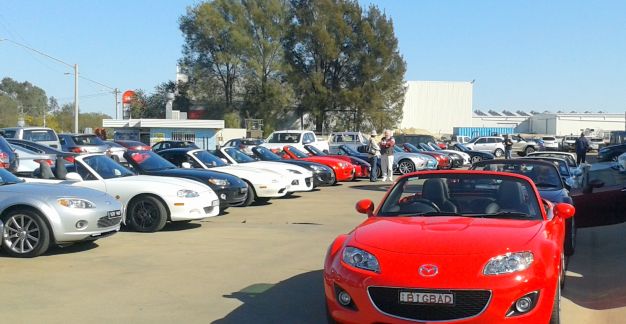A Riverina Ramble
13 September 2015 / Ken Keeling
“Some History of and Wineries in the Murrumbidgee Irrigation Areas”
Friday 21st through Sunday 23rd August 2015
Some considerable time ago I made a passing comment that the wines of the Riverina, particularly the irrigated vines of the Murrumbidgee Irrigation Area (MIA), had quite a bit of history behind them. This gave rise to a weekend run being scheduled for August 2015.
Maybe because I came from Griffith, although I had left it there 1963 to work in New Guinea, it seems to have been assumed I might possess the relevant local knowledge to plan a good run. My inadvertent comment in due course gave rise to my being tasked to organize the run, no doubt to see if my home town lived up to my promotion of it.
Notwithstanding my inclination to do so, it is not possible to see/do everything in a couple of days, so I decide to focus on history in the MIA that I knew - Sir Samuel McCaughey (father of irrigation in the region) and his mansion, now Yanco Agricultural High School, The Hermit of Scenic Hill, Griffith’s development and The McWilliam & De Bortoli families of winemakers.
My promotional effort must have been reasonable as our planning target of 6-8 cars was soon exceeded – 20 cars and 37 people confirmed their participation. I felt this was an extraordinary number for a weekend run – and on roads not too attractive to those who love exploring the twisty roads to which our MX5s are so well suited. It was also rather pleasing that two others of our group were ex-Griffith.
After some late concerns that a few individuals could not come, 17 MX5s assembled at the Border Lay-by near Hall early on Friday to depart, remarkably on time, for Jugiong. Our only straggler, who had a delayed departure from Canberra, managed to catch up at our regroup stop at Jugiong. That meant we had the as-planned ex-Canberra complement of 18 cars for our only sector of reasonably interesting road, via some 40 kms of by-ways, to Cootamundra. From “Coota” it was via the Olympic Way to The Licorice & Chocolate Factory at Junee for a well overdue coffee break - and to rendezvous with our Canberra Chapter’s two Riverina MX5 couples. After the caffeine fix, our full expected complement of 20 cars turned west at Old Junee and headed into real straight road territory, 40kms with hardly a bend, much less a decent curve, on the appropriately named Canola Way to Coolamon.
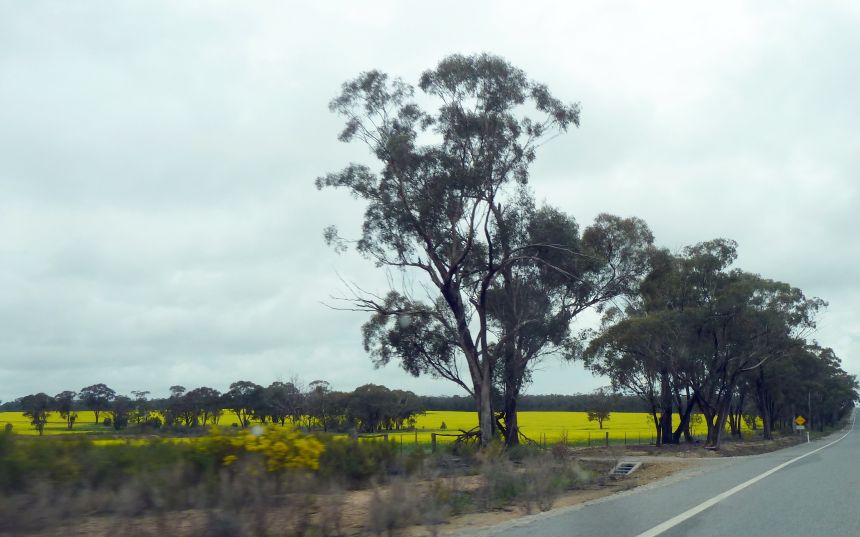
After Coolamon (other than in the heart of the villages) there were no bends at all for the 60kms of almost gun-barrel straight road to our lunch stop at Narrandera. Leaving Narrandera we joined another appropriately named road, Irrigation Way, and immediately crossed the carotid artery of the MIA, the Main Canal, near where it leaves Lake Talbot. This impoundment is where the Murrumbidgee waters, released from Burrinjuck Dam and diverted at Berembed Weir into the old riverways and linking canals, gravitate to provide irrigated life to the agricultural region that is the MIA. We shortly afterwards passed through the Narrandera Sand Hills and the first irrigated crops, Citrus orchards, before reaching our run’s first point of historic interest, an informative stop at Yanco Agricultural High School (YAHS).
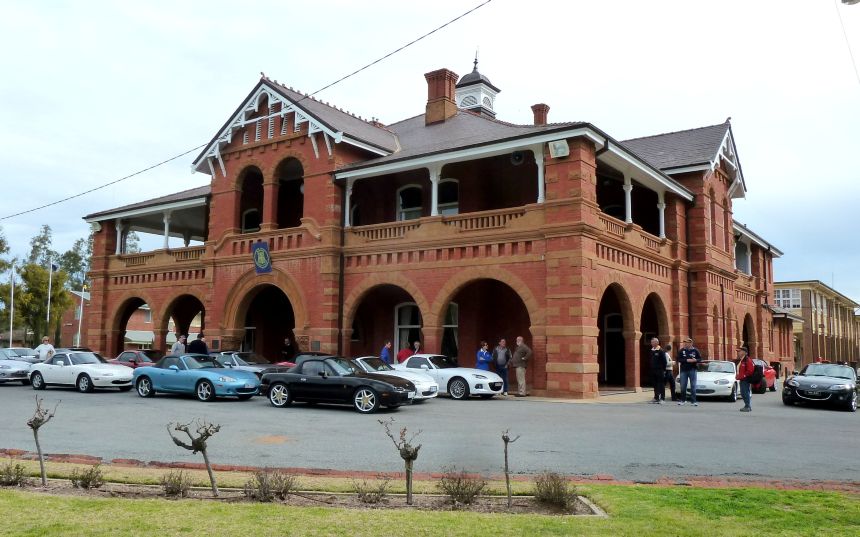
The “Yanco Ag” school is not only where I completed my secondary education but is also a keystone in the story of the MIA, being the home of Sir Samuel McCaughey, the father of irrigation in the Riverina. His mansion, McCaughey House, became the school’s foundation.
McCaughey was an Irish migrant who arrived in Australia in 1856, at age 22, and began life in Australia as a jackaroo, but was quickly promoted and within two years was managing “Kewell”, a large station in the Victorian Wimmera. He was both thrifty and astute and by 1860 owned “Coonong” in the Riverina, where he sank bores for stock water and constructed large dams to harvest surface water. In so doing, he was a pioneer of water-conservation in Australia.
By 1880 McCaughey had brought his landholding to about 3,000,000 acres (12,000 km²). He continued to prosper and to acquire properties and on 30th April, 1899, an article in “The Warragul Guardian” (Vic) proclaimed McCaughey to be “THE RICHEST MAN IN AUSTRALIA!”, reporting that “… the value of his 5.1 million acres of freeholdings was some two million pounds with stock … some 1.3 million sheep, 2000 horses and about 5000 cattle.”
McCaughey became a member of the New South Wales Legislative Council in 1899, and in 1900 he bought “North Yanco” and constructed some 200 miles (320km) of channels to irrigate 40,000 acres (160 km²) fed by Murrubidgee water raised by a steam pump, now displayed in the grounds of YAHS. The original canal is still beside the road along which we entered the school, but now crowded with bull-rush (cumbungi). The success of irrigation at Yanco encouraged the NSW government to proceed with Burrinjuck Dam on the upper Murrumbidgee River.
In 1906 the NSW Govt. decided to create an irrigation area north of the Murrumbidgee River, fed by the secured waters of Burrinjuck Dam. McCaughey’s “North Yanco” property was resumed by the NSW Govt. in 1910, but he was allowed to retain some 700 acres under crown lease. This land was the initial development of what is now the Murrumbidgee Irrigation Areas (MIA).
McCaughey was made a Knight Bachelor in 1905 and Sir Samuel died from heart failure at Yanco on 25 July 1919. He is buried in the grounds of St John's Presbyterian Church in Narrandera and his bronze memorial now stands by the lake at Yanco village, which we visited.
His death in 1919 saw this last 700 acre parcel of his former lands revert to government control in 1920. It was this property that was to shortly become YAHS.
So ends the story of one young migrant who not only literally succeeded in making his fabulous fortune but also left his mark on the history of NSW, the Riverina and the MIA.
But we are not yet finished with “Yanco Ag” – as a “Old Yanconian ‘49-er” (the year I started at YAHS) - I am proud of YAHS and I want you to know something about it. The school maintains strong links with former students (even really old ones) and the school administration welcomed a request for our Canberra MX5 group to both visit my old school and access McCaughey House.
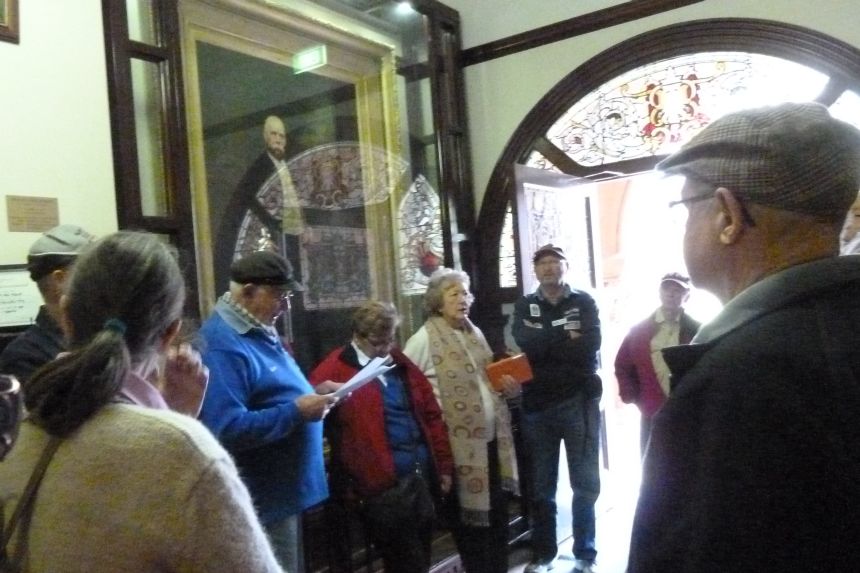
In the early 1950s, when I was at YAHS, it was boys only and the 200 odd student boarders were accommodated in two dormitory “Houses” (McCaughey and Mutch). In addition to our normal education curriculum studies to matriculation standard, Yanco Ag operated some 600 acres as a productive irrigation farm, staffed and worked on daily predominantly by the students as part of their rural educational activities. We had working draught and stock horses, sheep, a large poultry farm, a piggery and a dairy where the students’ twice daily hand milked about 40 Jersey cows. All students learned how to handle and work the stock and draught horses and how to properly husband the other stock. Crops grown on rotation under irrigation included rice, cereal crops for stock food (wheat & oats) and other grains such as millet and sweet sorghum for silage. There was a productive vegetable farm and a fruit orchard. At that time, YAHS students also enjoyed several thousand acres of pristine River Red Gum forest as an extended “playground” adjoining the school. We learnt to swim and were taught life-saving in the Murrumbidgee and had carnivals on its beach near Euroley Bridge. We got up in the small hours to bring in the cows, made the sweet sorghum into silage for the dairy and fought the Murrumbidgee when it flooded. It is a bygone era but a period that taught responsibility, encouraged initiative, obligation and co-operation and, for most of us, one of great memories, long lasting friendships (the ’49-er Yanconians still meet up annually in early September – this year in Mulwala on the Murray) and a rich experience that fitted us well for our future lives.
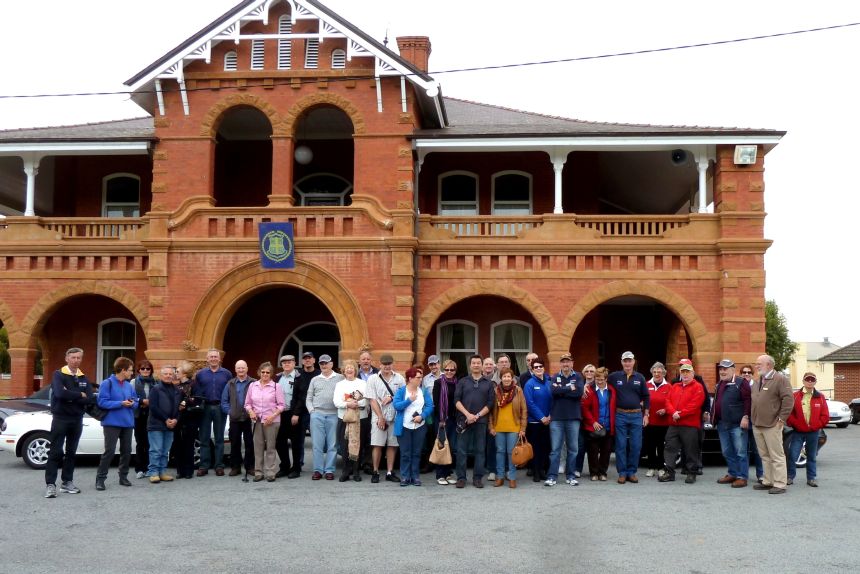
With the history talk over and photos taken, before we departed some took time to admire the magnificent stained glass window up the main stairs, whilst others wandered the grounds of, McCaughey House.
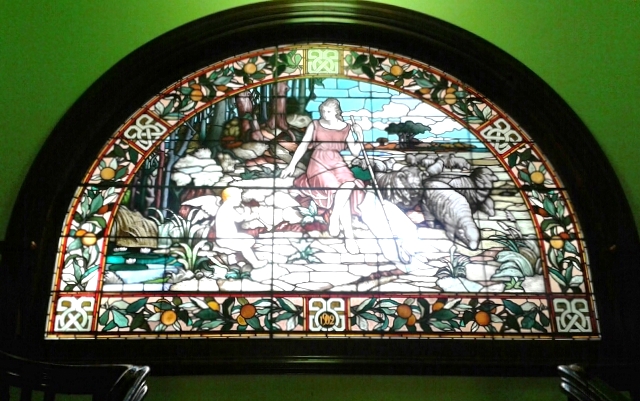
Samuel McCaughey also had an important role in the breeding of sheep in the Riverina, starting his experiments in 1871. This window depicts the “Wrinkly Vermont” sheep that he imported from America in 1886 in an effort to develop a breed of sheep better suited to the local conditions, initially for fleece and later for meat.
From YAHS, it was just a short drive into the village of Yanco to say farewell to Sir Samuel, standing in bronze splendour by the lake filled with irrigation water.
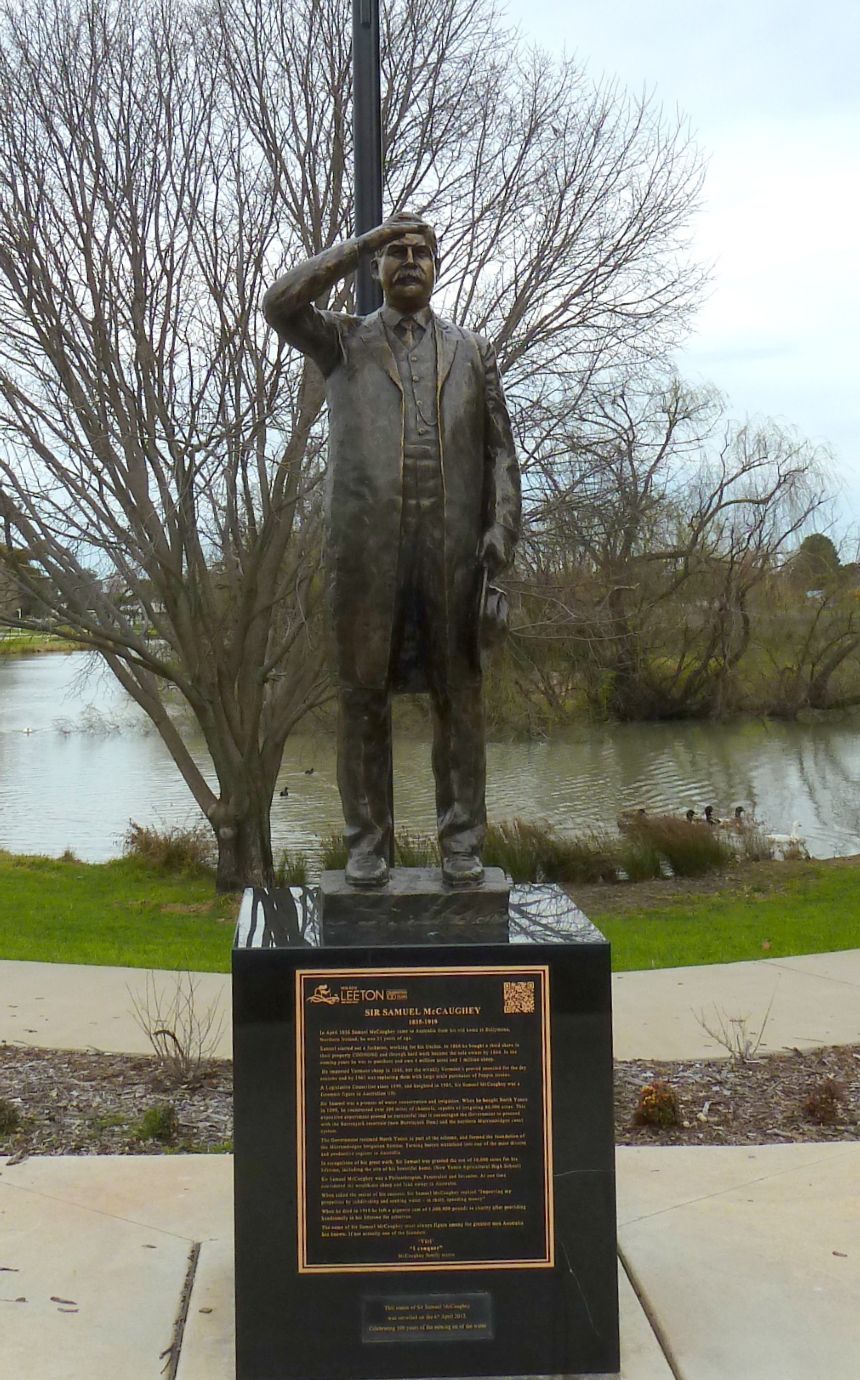
From Yanco, we took the back road to bypass Leeton township, so avoiding the need to traverse the main street with its urban shopping traffic. Then, once back on the Irrigation Way, it was another 60kms of irrigated landscape - orchards, rice farms and a much increased area of vineyards. However being very flat country, it was also a much less than exciting straight road, with one major curve, two rail crossings and a right angle turn, until we reached the outskirts of Griffith. Here we detoured to Beelbangera and then took a road that runs along the crest of Scenic Hill and stopped at The Hermit’s Cave Lookout for some more local history..
This time my second story was about another young migrant who came to find his fortune in Australia. This one, Valeri Ricetti; “The Hermit of Scenic Hill” was, unfortunately, significantly less successful than McCaughey!
Perched above the City of Griffith on Scenic Hill, the Hermit’s Cave complex was once home to the reclusive Valeri Ricetti. Ricetti arrived in Australia in 1914 at the age of about 17 on money lent by an uncle. He had been an apprenticed stonemason and could speak French, Italian and German and quickly became fluent in English. During several years of travel doing casual labouring, Ricetti became friendly with several Italian families in Broken Hill, where he also managed to be rejected romantically by a barmaid, left there broken hearted in 1918, in Adelaide lost his wallet containing his savings (an entire year’s wages) in an unfortunate adventure at a brothel and then managed to get jailed for a misdemeanour. Having paid his societal penalty, Ricetti returned to the countryside, working and travelling around Victoria for the next decade. In 1928 Ricetti was a sailor on a paddle steamer that worked the Murray, Murrumbidgee and Lachlan rivers and finally left that riverboat at Hillston. From there he walked 70 miles (110 km) along the railway line to Griffith where he arrived in a rainstorm. Shunning society and virtually destitute, he sought shelter in the rocky escarpment of Scenic Hill, where he found a cave-like overhang, Ricetti not only spent the night there but settled on the escarpment of Scenic Hill to make it his home. From 1929 until 1939 Ricetti created gardens, a main bedroom, kitchen and a chapel. (I remember my father taking me to see the Hermit’s Caves just before he went to war in 1939. I also visited it numerous times with my mates during WW2, about the age of 8 or 9, but as we were unaware he had been interned, we were always scared we might meet The Hermit!) Valeri Ricetti’s decade of dedicated labour created a complex of stone structures covering an area of some 16 hectares that is today known as The Hermit's Cave.

In the xenophobic atmosphere of war, Ricetti’s lifestyle and Italian origins were suspect – he was after all an “Italian” - and his cave was a vantage point that overlooked railway traffic. Despite nothing incriminating being found in a search of his complex, Ricetti was arrested and interned as an “enemy alien”, from March 1942 to Dec 1943.
On his release, Ricetti lived for the next 8 years with a local Italian farming family who he had originally met in Broken Hill. However, during this time he continued to visit and tend his cave complex at Scenic Hill, which he considered to be his true home and called it “la mia sacra collina” – which my very limited Italian skills translate to ‘my sacred hill’. In 1952, in poor health but with an obvious intention of returning, he travelled to Italy to visit his family but died shortly after arrival there. Whilst his body rests in Lombardy, near the Italian Alps, local folk-lore suggests that Valeri Ricetti’s soul remains on “la mia sacra collina”.
Ricettii’s cave complex is now recognised as a rare example of an Australian hermit's domain and is listed on the State Heritage Register of NSW. However, due to uncaring visitors, the complex is now quite degraded and somewhat unsafe to go clambering around. Consequently, we confined ourselves to the Caves Lookout and no one went exploring the actual remnants of Ricetti’s caves.
Whilst Valeri Ricetti did not succeed in life, unlike Sir Samuel McCaughey, each in their unique, own way contributed significantly to the history and folklore of the MIA and Griffith.
At the end of our visit to The Hermit’s Cave, our entourage made its way to The Kidman Inn, our accommodation for the weekend. The convoy had worked remarkably well for over 400kms, losing contact with only 3 cars in the final stage as we entered Griffith’s environs, but who all found their way to the rendezvous at the Hermit’s Caves within a few minutes of the main group. And, surprisingly, no-one seemed unduly bored by the history lessons.
Friday night turned into a pleasant evening, with a convivial gathering in one room, talking animatedly and consuming appropriate amounts of pre-dinner wine, before all 37 MX5-ers adjourned to the resident restaurant for a very pleasant meal of cibo Italiano (Italian dishes), some choosing to dine a la carte whilst others opted for the degustation menu.
Saturday started early, at the Aeroplane carpark underneath the Korean War vintage “Fairy Firefly”, a Griffith landmark, where we were joined by several local car enthusiasts, before receiving at the Interpretative and Information Centre a most interesting presentation on the origins and history of Griffith by, John Robinson, a local historian, a former compatriot of mine, an ex-school teacher at Griffith - and a former teacher of one of our group!

Located 635 kms west of Sydney, Griffith is some 420ft (about 130m) above sea level – also coincidentally about 420 miles from Adelaide, so is pretty flat country, falling one ft/mile to the west. In 1817 the explorer John Oxley passed not far north of the Griffith area and dismissed the region as being ‘uninhabitable and useless to civilized man’. Oxley was badly mistaken - thanks to irrigation the region now hosts an abundance of agriculture and is one of the most diverse and productive regions in Australia contributing over $5 billion annually to the national economy. The MIA is also reportedly the largest gravity fed irrigation scheme in the world.
Over the past century, Griffith and its surrounding villages have grown and developed thanks to irrigation and hard-working soldier settlers and Italian immigrants. With their passion for food and wine, gli Italiani have influenced Griffith’s evolving into today’s cosmopolitan community of some 26,000 people, of whom 70% now have some Italian heritage.
The largest centre in the MIA, Griffith is named after Arthur Griffith, the NSW Minister for Public Works from 1910 to 1915, the period when people with foresight and drive, like Sir Samuel McCaughey, saw that Burrinjuck Dam was built and the MIA established. Both Griffith and the other MIA town, Leeton, were designed by Walter Burley Griffin, who designed Canberra, and his trademark tree-lined streets and radial patterns of Canberra can easily also be seen in Griffith.
Griffith is also the geographic, production and industrial hub of the rich MIA, Australia’s largest citrus producing area yielding over 230 000 tonnes of citrus annually. Rice is also a significant crop in the MIA and Griffith is Australia’s largest poultry and egg producer, as well as producing significant amounts of stone-fruit, cotton, sheep, wool, canola, fruit and vegetables - including gherkins for McDonalds.
It is also a very large viticultural area. In 1996 the MIA wineries produced about 80 per cent of NSW's and 20 per cent of Australia's wine grapes - 110 000 tonnes were harvested with Semillon and Shiraz accounting for the bulk of production. In the last two decades wine grape plantings have increase enormously throughout Australia but, due to fickle wine lovers’ palates, Semillon is no longer a viable variety and is being pulled out.
With grape production of 300,000 tonnes in 2013, the Riverina is the largest wine grape producing area in NSW (but now only 60% of grape tonnage) with vineyards covering an area of over 20,000 hectares. Riverina wine makers produce one in every four glasses of Australian Wine - with winemakers generally being large-scale producers of high-quality, value-for-money table wines. There are 16 wineries, many with cellar door facilities, of which we visited three.
After the history session, our entourage made an impromptu visit to the local MX5 dealer, “Dom’s Motors Mazda”, much to the surprise of Dom! At the Aeroplane Carpark we had spontaneously gathered into our group one of only four(?) MX5s in Griffith. So it was 21 MX5s that visited Dom’s, ostensibly to see his showroom ND (but we already had one with us). Our cars embodied every model of MX5 made – early through late model NAs, NBs, all three series of NC and a solitary ND (a lovely red one, acquired by our Jan only 10 days before!) were all there.
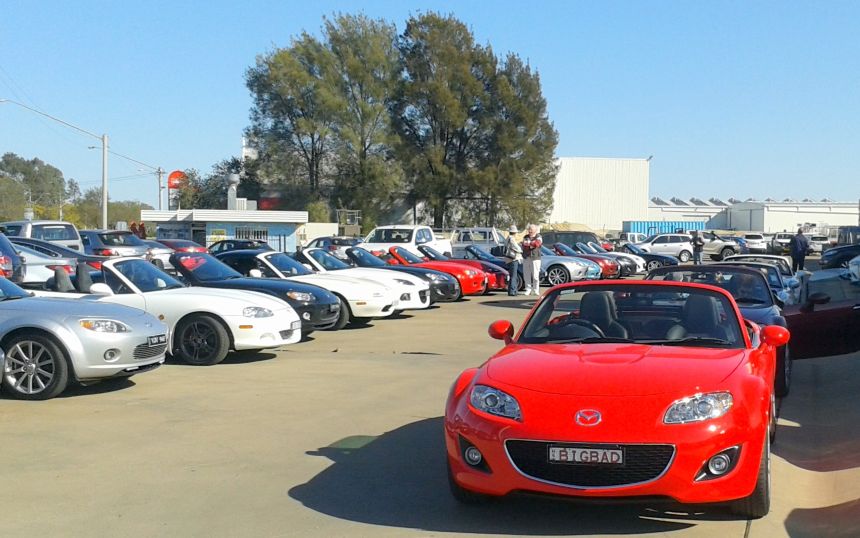
Griffith had rarely seen such an assembly of beauty – except possibly at the Venetian Carnivals of the 1950s! And Dom was sufficiently impressed to marshal the photographic talent of his staff to record our visit. That record is in “photos” at website – https://www.facebook.com/domsmotors
In keeping with the Italian influence on Griffith, our next stop was at Codemo Smallgoods, makers of several types of excellent air-dried fermented salami, prosciutto and capocollo (commonly known as coppa). Steve Codemo gave a most informative talk and product tasting, followed by a tour of the production facilities Codemo's recipe came over from the “Old Country” in the 1950’s, where Italo and Silvano Codemo used to help their elders to make home-made salami’s. The current generation of family members continues utilising traditional methodology with modern technology to produce their current range of excellent products. Many of these were tasted by the group, including Veneto salami from the North of Italy and the Calabrese style from the Southern region, where many of Griffith’s Italian families originated. At the end of August each year Griffith holds a Salami Festival – with the competing products being evaluated by international judges -and the town is usually booked out! Maybe we should go?
A short drive took us past the “Three Way Bridges” to our next point of interest, at Calabria Family Wines, makers of the Gold Medal winning Three Bridges Durif – a very pleasant vino well matched to pasta. Calabria’s make a range of very palatable wines that were enthusiastically sampled (but with appropriate restraint by the drivers). The Three Bridges and Richland lines are their best known labels and questions were well fielded by Peta Serafin and her cellar door staff. Needless to say, some wine was procured for later consideration and evaluation.
The “Three Way Bridges”, as they were known in the 1950’s are not only the origin of the “Three Bridges” label for a line of Calabria’s wines, but also the site of an unpleasant discovery by a water bailiff one morning in the 1950’s. Adjusting the weir structures at the bridges, to regulate water levels in the irrigation canals, he hooked up a male body that was minus an essential part of its’ masculinity. No - it was not an incident in anyway related to the Italian community – just a woman taking affirmative action against what she perceived as poor behaviour reflecting a breach of her expectations.
From one winery to another - this one at McWilliam's Hanwood Barrel for lunch, near the farm on which I spent my early teens and from where I went to YAHS. But no lunch before I subjected the group to yet another history lesson – after all I was asked to do a ”History and Wineries Run”!
It is in now some 138 years since Samuel McWilliam first planted vines in 1877 at “Sunnyside” near Corowa. When Samuel retired in 1891, his children John James (J.J.), Thomas & Eliza, turned that vineyard into a successful operation. In 1895 J.J. moved to Junee with his siblings to establish a new vineyard and winery. Eliza, who had turned to winemaking, won the first wine awards for McWilliams in 1897.
The first irrigated farms in the Hanwood area were made available in 1912 and J.J. (and his eldest son, Jack), arrived in 1913 bringing with them a large collection of vine cuttings. They quickly established a viticultural nursery, carting water until irrigation arrived some months later. They then acquired two farms and set out vineyards and planted out the cuttings. The first grapes were picked in 1916 and sent by rail to be processed at their to Junee winery. The original Hanwood Estate winery was commissioned in February 1917, with a first vintage of 170 tons.
So – whilst Corowa on the Murray is on the southern fringe of the Riverina and Samuel McWilliam was making wine there in in the 1880’s, the Riverina’s commercial winemaking industry certainly dates from the McWilliams at Old Junee in 1897 and Griffith’s from 1913, when J.J. McWilliam and Jack planted the first grape cuttings at Hanwood. They built this Winery in 1917 to process those grapes. By so doing the McWilliams pioneered the Griffith district as a premium winemaking region with a high reputation that continues to the present.
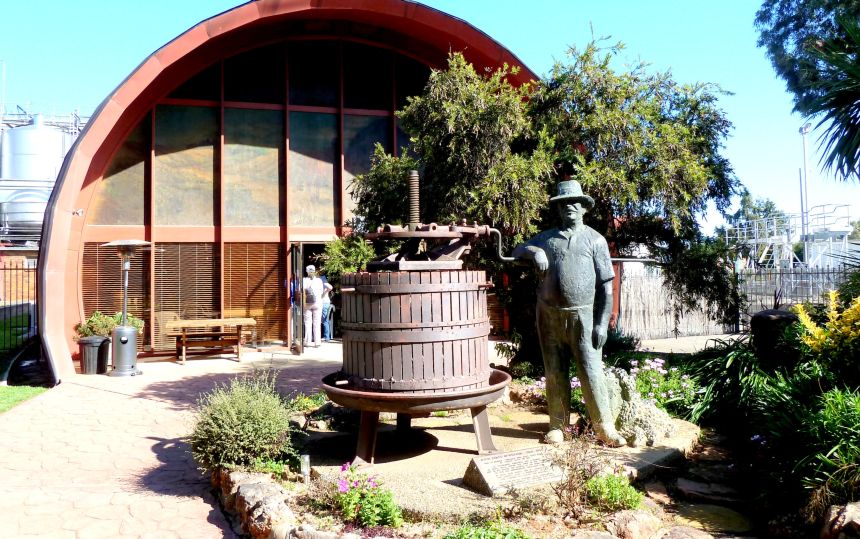
Notwithstanding that I had been working on my father’s farm, I earned my first cash pay packet picking grapes here in McWilliam’s Hanwood vineyards. On our farm, my father planted the vine varieties that Stewart McWilliam specified that the winery needed in the 1950s - White Shiraz” (now better known as Trebbiano), Pedro Ximinez (for sherry), Doradillo for brandy and Grenache for Port, but now also made into a very pleasant red table wine.
My family’s links with the McWilliams date from 1936, when my father was taken by his friend, Glen McWilliam, for a flight in a De Havilland Moth out of the “cow paddock” at Mascot - and a few days later was best man at my parents’ wedding. I grew up in regular contact with Glen’s family and became friends with Ross and Max, who were close to my age. Glen also took me for my first flights in light aircraft, a Klemm Eagle, VH-UTI (recently restored by an enthusiast as a flying vintage ‘plane) and his little twin engine, twin tail Miles Gemini.
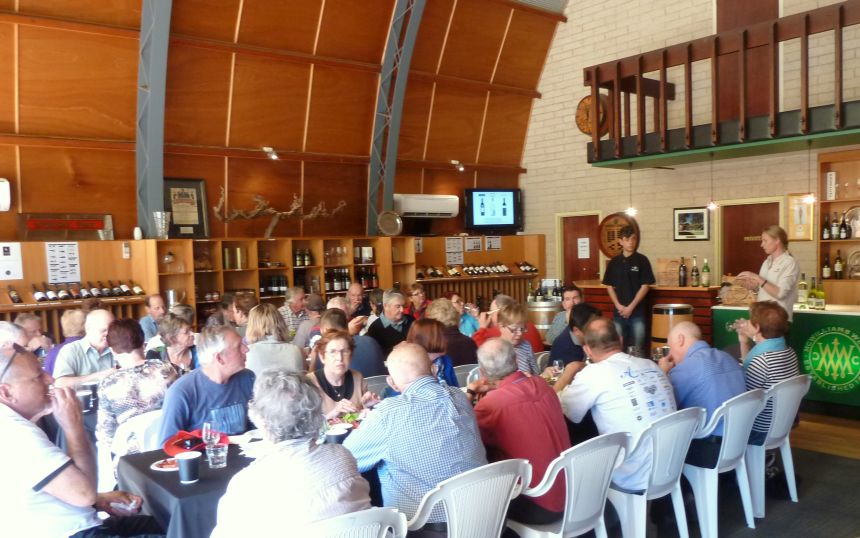
Following my Hanwood history lesson, everyone enthusiastically sat down for a most pleasant Italian-themed lunch of antipasti e vino, very similar to those I enjoyed with Italian family friends, sitting under vine covered pergolas in the 1950’s.
During our lunch, Karin Penninga, the Cellar Door Manager, gave a very informative talk on vines and wines to guide us through the various wines we tasted during our lunch.
By visiting the Hanwood Estate’s “Barrel” we shared some significant history, both of Riverina winemaking and of the McWilliam family, who after 138 years are in their seventh generation of winemakers. The McWilliams are not of Italian extraction but I think we were privileged to have our antipasti lunch at the founding place of the Riverina’s reputation as a source of excellent wines.
The rest of Saturday, after our lunch and wine tasting was completed, was left as the respective individual’s own choice of “free time”. Some took in additional places of interest, several visited local friends and others retired to rejuvenate themselves and better prepare for the evening with “Nonno/Nonna” naps!
Saturday evening emerged hazily from a most convivial late afternoon after someone organised another “wine in a room” event – our Convenors had, very thoughtfully, secured a supply of very palatable red wines, others produced some nibbles and- ecco la - camaraderie blossomed.
Although there was no formally organised Saturday evening function, some 20 of us gathered at Giuseppe’s, a convenient pasta e pizza trattoria and rounded off an enjoyable day with good food, some wine and excellent companionship. At Giuseppe’s yet another local car club member (this one a classic cars enthusiast) joined us for the meal and presented us with a small memento of our visit to Griffith and contact between like-minded people.
Even the sudden shower of rain, encountered as we walked back the kilometre to the motel, could not dampen the enjoyment of yet another enjoyable day of MX5-ing.
Despite rain during the night, Sunday dawned fine and encouraged some early risers to visit the local Griffith Rotary Community Markets whilst others took an opportunity to sleep in before facing the final day of our excursion.
First stop after checking out and departing our motel was at the Rotary Club Lookout on Scenic Hill, overlooking the town to the south – for yet another, but in this case final, brief talk on Griffith’s history and a few statistics about its rural industries and economy. A short drive had us all at the interesting Griffith Pioneer Park Museum, a historic collection of buildings, artefacts and pictorial presentations which tell the story of the town and its evolution from the “Bagtown” of 1912, a hessian covered village of construction workers, to the cosmopolitan modern rural city that is Griffith today. We spent an hour wandering among the pine trees and exploring old buildings and almost everyone found something of particular interest to them and all left well satisfied that it had been a site worth the visit, albeit too short for some.
The final stop on our visit to Griffith was at De Bortoli’s Wines at Bilbul, site of their original winery, founded by another young migrant who came to Australia seeking a new life. Vittorio De Bortoli was the father of a friend of mine when I was a much younger man. I became a casual friend of Deen’s through a mate of mine, Ian “Frosty” Cummins, who later married Deen’s sister Eola. Deen was the same age as me and we got on well and I used to visit the De Bortoli farm with Frosty and others - several of whom flew model aircraft in the paddock opposite the winery.
But back to the founder of De Bortoli’s, Vittorio, who came with little, but worked hard, suffered the same harassment many other Italians did during WW2 and very clearly succeeded in his ambitions. Apart from establishing a new dynasty of winemakers, Vittorio set about experimenting with making wine from rotted grapes. He was regarded as very eccentric in this endeavour, if not a little crazy, by the locals in the 1950s. When conditions are humid, which they can sometimes be in hot, irrigated areas, what my father called the scourge of the vineyard, “bunch rot fungus” can disastrously affect the crop, with dire economic consequences – we spent a lot of time and money spraying our grapes, particularly the Pedro Ximinez, trying to keep it in check as the grapes ripened
What Deen’s father knew (and we didn’t) was that, if conditions dried out in the vineyard, “bunch rot”, caused by the botrytis fungus, can, turn into “Noble Rot” and facilitate the making of some spectacular sweet wines. Deen was involved in the winery business when I knew him and later when he had taken over managing the winery, he and his son Darren, continued Vittorio’s work - the now famous Botrytis Semillon “Noble One” and “Black Noble” are the culmination of their endeavors. Unfortunately, Deen died pre-maturely in 2003, leaving Darren, the third generation, to have the stewardship of what is now one of Australia’s most successful family of winemakers.
Vittorio De Bortoli’s story is the third of those three young men who came to this part of the Riverina and in their separate ways became integral parts of the history of the MIA.
One final thing of interest – among other of the De Bortoli product lines from the Bilbul winery are their award winning Sacred Hill varietal wines, offering very good quality and value.
Some of those who were really listening to my talk at the Hermits Cave Lookout will have noted that I pointed out that, in the middle distance to the east, we could clearly see De Bortoli’s original winery at Bilbul. I also said that we were standing on Valeri Ricetti’s “la mia sacra collina” – his Sacred Hill. As one can clearly see Scenic Hill from the winery, I don’t think that the label name of those Sacred Hill varietal wines is any co-incidence, but rather “uno saluto”.
Because of this, it seemed to nicely close the circle of my local history stories, so I chose De Bortoli’s at Bilbul as the place to bring our run to its formal close and let people find the own way home.
I hope everyone else found that it was an appropriate point to finish our visit to an important part of the Riverina and our ramble an interesting way to experience some of the“History of and Wineries in the Murrumbidgee Irrigation Areas”.
My major concern when planning this run was that there are not a lot of “MX5 roads” out on the flat lands of the irrigated Riverina, so something else of interest would have to make up for the lack of exhilarating driving. Hopefully we achieved that objective during the three days of our foray to “straight road territory”.
My trip meter recorded 814 kms from home to home and I enjoyed both the company and the opportunity to share some of my home region’s history with the Canberra MX5-ers who came along. I think we can tick this run off as another successful Canberra Chapter outing.
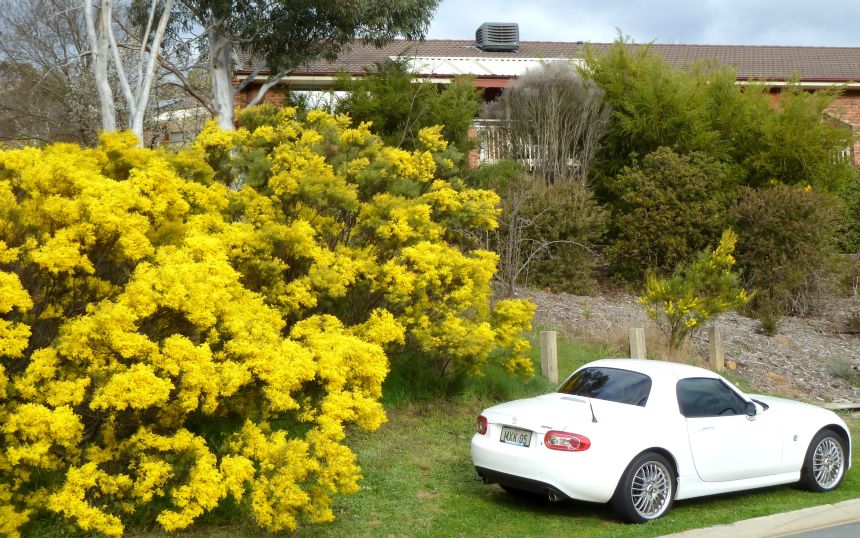
Thanks to the “Riverina Ramblers” who provided additional photos for me to choose from – & especially to Lyell, Martin and Tony, four of whose photos are included above (initialled).
The material above is the edited memories of Ken Keeling (Griffith 1936-1963, YAHS 1946, 1952-53) supported by statistical information and supplementary material sourced from:
- http://www.yancoag-h.schools.nsw.edu.au/our-school/history
- Yanco Agricultural High School - A Brief History: W.H.(Bill) Barwick, Old Yanconian
- Head Teacher, English & History, 1988-2006, Secretary, Old Yanconians Union.
- www.griffith.nsw.gov.au and https://en.wikipedia.org/wiki/Griffith
- www.mcwilliams.com.au
- www.debortoli.com.au

